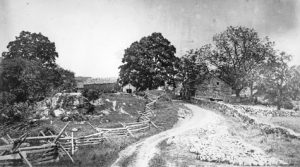There are many designations and levels of protection for historic properties, but all are intended to honor architectural and historic significance, as well as encourage preservation of sites that are essential to a community’s vitality, heritage and character. See distinctions below.
National Historic Designations
National Historic Landmark

Built: c. 1730; Listed on the National Register of Historic Places: 1988; Declared a National Historic Landmark: 1991
This is the highest status conferred in the United Stateans and is an official recognition by the federal government of a property’s national importance. National Historic Landmarks are considered significant to all Americans because they possess exceptional values and qualities that contribute to understanding our country’s heritage.
The program is administered by the National Park Service, and nominations are subject to approval of the Secretary of the Interior. Designation of a property does not prohibit the owner from making alterations unless federal funding, licensing or permits are involved – in which case, the proposed changes are subject to review under the provisions of the National Historic Preservation Act (1966). Connecticut has nearly 60 National Historic Landmarks; Bush-Holley House is the only National Historic Landmark in Greenwich designated for both its important Colonial history and the American Impressionist art colony that flourished there.
National Register of Historic Places
Maintained by the National Park Service, the National Register of Historic Places is the official list of the nation’s historic places worthy of preservation. While far more inclusive than the National Historic Landmark listing, the register nevertheless requires listing through a nomination process. Listing includes individual properties and historic districts. While designation does not restrict the rights of the owners in the use, development or sale of their property, a review is required if proposed changes involve federal funding, licensing or permits.
More than 40,000 Connecticut buildings are included on the National Register, which is administered in Connecticut by the State and National Register Coordinator at the State Historic Preservation Office in the Connecticut Department of Economic and Community Development Offices of Culture and Tourism. All National Register properties are first listed on the State Register of Historic Places.
Click here to see Greenwich’s National Register of Historic Places sites.
State Historic Designations
State Register of Historic Places
This official listing recognizes a property’s importance to the historical development of Connecticut. All properties listed on the National Register of Historic Places are automatically conferred a state designation, but a property may be listed on the State Register of Historic Places without being included on the National Register of Historic Places. In Greenwich there are nine extant that are not listed on the National Register.
Designation at the state level does not restrict the rights of property owners but it does provide special consideration under the State Fire and Building Code for historic buildings and the Americans with Disabilities Act. Properties are nominated by the State and National Register Coordinator at the State Historic Preservation Office in the Connecticut Department of Economic and Community Development Offices of Culture and Tourism.
Click here to see Greenwich’s State Register of Historic Places sites.
Historic Overlay Zones
Planning and Zoning may grant Historic Overlay, either Historic Residential/Office Zone (HRO) or Historic Overlay Zone (HO), or Façade Easement status to properties in Greenwich. The designations allow for zoning bonuses in exchange for a property owner’s agreement to preserve and protect a significant historic or architectural asset. After designation, any application for alteration to the historic structure is referred to the Historic District Commission for a Certificate of Appropriateness.
An overlay zone is an additional layer of regulations for a specific area that is laid over the underlying zoning regulations. The base zoning regulations continue to be administered, but the overlay adds another level of regulations to be considered. With Historic Overlay Zoning, historic district design review is established through a zoning ordinance rather than an independent process such as establishing a Local Historic District (LHD). This Historic Overlay tier is applied to an area considered worthy of preservation because of its architectural, cultural or historic significance.
Historic Overlay Zoning is another avenue a Connecticut municipality can use to protect historic areas and structures rather than establishing a Local Historic District. In 1977 Connecticut General Statute (CGS) 8-2 was amended to allow zoning commissions to consider historic factors when rendering a zoning decision.
In certain instances it may be more beneficial for a municipality to use zoning regulations for historic preservation than to establish a local historic district/property. A zoning change (overlay) does not require the two-thirds approval of property owners in order to establish it or approval of an ordinance by the municipal legislative body. To amend a local zoning ordinance and add a Historic Overlay, it is not necessary to have a community election.
Another benefit for a zoning board review is that they can regulate the use of a building, whereas a Local Historic District Commission cannot. Although it may appear that an LHD Commission may have more authority over a “district” because a zoning commission decision may be overturned or undercut by a zoning board of appeals (ZBA), the zoning commission does have the power to prohibit ZBA from granting use variances in certain instances. A zoning commission can implement a similar control over individual projects through a special permit that an LHD Commission can exercise through a “ertificate of Appropriateness. Using a Historic Overlay Zone may be a good alternative to establishing a local historic district when certain required criteria cannot be met, such as obtaining the required two-thirds property owner vote.
However, when establishing a Historic Overlay Zone, it is important to coordinate preservation regulations and zoning rules. Problems can arise when there are incompatible use regulations. This frequently happens when the areas historic uses do not match the current zoning designation. For example, when a neighborhood of historic residential buildings is zoned commercial, there is the possibility of inappropriate alterations to convert the residential buildings to accommodate commercial uses. Other issues to take into account are density, lot sizes and off-street parking.
A number of Connecticut towns have created historic overlay zones. In Greenwich the Historic Overlay or HO designation is “a tool used by Planning and Zoning to encourage retention of notable structures by providing economic incentive through the easing of zoning restrictions in return for permanent deed restrictions including mandatory review of any changes to historic assets.” These individual properties are located outside the town’s two Local Historic Districts and can be designated as either a Historic Residential/Office Zone (HRO) or Historic Overlay Zone (HO). Greenwich currently has six HRO properties and 16 HO structures. The overlay zone encourages the adaptive reuse of buildings and allows input from the Historic District Commission on appropriate changes. The greatest benefit is that upon completion of the work, an easement is granted to the municipality, enforceable by the Historic District Commission.*
*Source: CT Trust for Historic Preservation
Click here to see Greenwich’s Historic Overlay Zones.
Local Historic Designations
Local Historic Districts and Local Historic Property Designations
A Local Historic District offers the most protection for significant historic and architectural buildings in Connecticut and allows municipalities to establish districts for which exterior architectural changes are reviewed by a local preservation commission. This allows towns to ensure that alterations, additions or demolitions are in keeping with the special character of the designated district.
A Local Historic District (LHD) consists of a contiguous area of buildings and structures that represents either a distinct period of significance in the community’s history or the evolution of the community over time. CGS Section 7-147b defines the historic district as “an area, or a cluster of related buildings, or objects and structures, in a compatible setting which, taken as a whole, visually expresses styles and modes of living representative of various periods in American history.” In general, an LHD is an area with clear boundaries enclosing a contiguous set of historically or architecturally significant structures that are related through proximity, ownership, history or use and that together tend to visually represent the community’s heritage. The LHD is different from a National Register or State Register historic district in that it provides for the local review of any exterior work that is visible from a public street, place or way. Properties within the LHD are subject to review, regardless of the age or condition of the specific building or structure. There are exceptions that include properties owned by higher education institutions and state-owned properties.*
Source: Handbook for Historic District Commissions and Historic Property Commissions in Connecticut
Note: This Greenwich town designation is performed with state approval. While we’re not directly involved with the approval process, the Historical Society can be instrumental in providing direction, assistance, information and resources to assist in obtaining that designation.
Designation subjects exterior changes to review by the Greenwich Historic District Commission. These local designations offer the most protection and strictest regulation for significant buildings and sites in Connecticut, and are intended to ensure that alterations and additions are in keeping with the character of the district or building in question.
A Local Historic Property (LHP) consists of a single building or site that represents important historical events, trends and architectural styles in the community. CGS Section 7-147p defines the historic property as “any individual building, structure, object or site that is significant in the history, architecture, archaeology and culture of the state, its political subdivisions or the nation and the real property used in connection therewith.” The LHP designation is suited to important historic, architectural or archaeological resources that are isolated or widely separated from related sites, but whose preservation and appearance are important to the sense of the community’s heritage.
Click here to see Greenwich’s Local Historic District and Local Historic Property Designations.
Scenic Road Designation
 Rural and scenic roads are a valuable and essential part of Connecticut’s notable landscape. Designating roads, both state and local, has proven to be an effective method in preserving and protecting these vital byways from alterations that would change and diminish their appearance including widening, rerouting, destruction of stonewalls and bridges, and the removal of mature trees
The Town Scenic Highway Statute authorizes a town’s legislative body to adopt a scenic road ordinance to protect its town roads from improvements that would impair their scenic character. An ordinance would:
Rural and scenic roads are a valuable and essential part of Connecticut’s notable landscape. Designating roads, both state and local, has proven to be an effective method in preserving and protecting these vital byways from alterations that would change and diminish their appearance including widening, rerouting, destruction of stonewalls and bridges, and the removal of mature trees
The Town Scenic Highway Statute authorizes a town’s legislative body to adopt a scenic road ordinance to protect its town roads from improvements that would impair their scenic character. An ordinance would:
- Designate specific town roads or portions of roads as scenic and/or delegate the power to designate scenic roads to the Planning Commission or Planning and Zoning Commission, prescribing the criteria for designation.
- Specify what alterations or improvements are prohibited or permitted under certain conditions for designated scenic roads.
References
Handbook for Historic District Commissions and Historic Property Commissions in Connecticut
Visit the Archives to take full advantage of this truly unique resource.

